A week in the shop
Published 21 Sep 2020
Tags: verkstaden
This week has been mixed in terms of build progress. The neck for the guitar I’m currently building has stalled due to lack of suitable band-saw. Whilst I have ordered a band-saw for my new workshop, it won’t arrive until later next month, so I thought I’d use the one at the community workshop I used to be based in, Makespace. However, in unfortunate timing it turns out that their band-saw had to have the table replaced, a task which has been done, but the new table isn’t compatible with the old mitre fence, something I need when cutting the headstock, so it’s no-go for me until that gets replaced. They’re working on it, but there’s no guarantee as to when it’ll be done.
This is a bit of a show-stopper. I have a couple of options, but I thought first I’d see if the new mitre fence is installed before I’m next back in (I drop by once a week to have coffee with a friend who works there) otherwise I’ll probably look to use the CNC-router that’s in my new workshop to remove the same material as I would have done with the band-saw.
I continued to work on the body for the guitar, and here I ended up struggling with the choice of wood I’d made for this body. Because this guitar is an excuse to learn the workshop rather than for a specific client, I’d used a bit of lightweight poplar I’d picked up a while back from MAC Timbers. Unfortunately I’ve discovered that whilst it is nicely light, it is also incredibly soft, which has been causing me issues.
When we last saw the body in my weekly updates I’d glued on the wings to the lower bouts of the body, the piece of wood itself just being slightly too narrow for the entire guitar. Any time you joint bits of wood, at least if you’re not using pins or such to guarantee alignment, you’ll find that join is slightly out on one axis or another; this is why in general when thicknessing wood for bodies I stop a millimeter or two short to allow me to do a final leveling pass once everything is glued up.
You can see in this picture how the main bulk of the body sits a little higher than the wing:
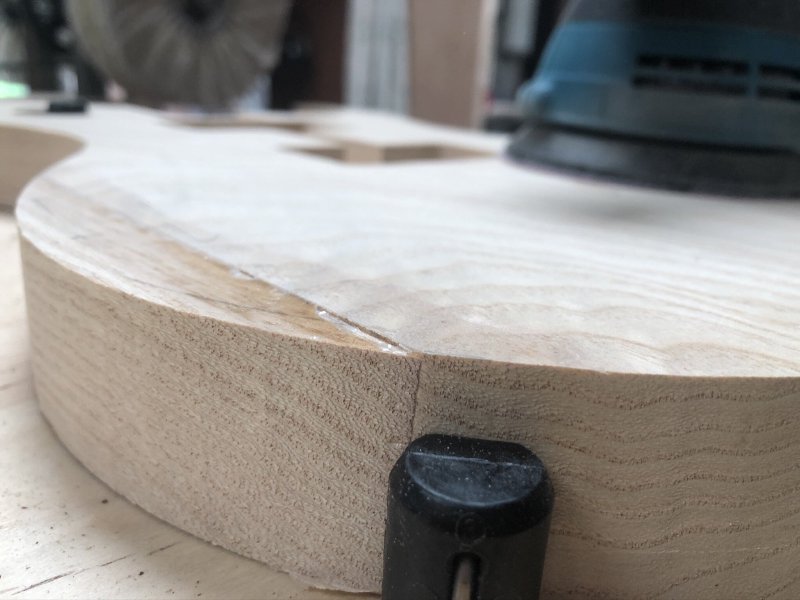
My first task then was to remove the excess glue and level everything.
I had planned to just use a plane or a sander to do this, but I quickly aborted this as it was too hard to remove just the wood I wanted due to how soft this particular bit of poplar is. As I sanded, no matter how much I trued to keep things level, the edges started to round off, creating a slight slope away from the centre. Having ruined an entire neck due to this sort of mistake last year I quickly aborted when I realised this was happening. I suspect the issue was the excess glue was much harder, creating a ridge that was ever so slightly tilting the sander.
I could have tried planing this, but again given how soft the wood is I was worried about excessive tearing if not done carefully. Thankfully I had a plan B, which is just run the entire thing through a thicknesser. Unfortunately the thicknesser in my workshop isn’t quite wide enough for a full guitar body, but given I was going into Makespace anyway, which was to just run the body through their slightly wider one:
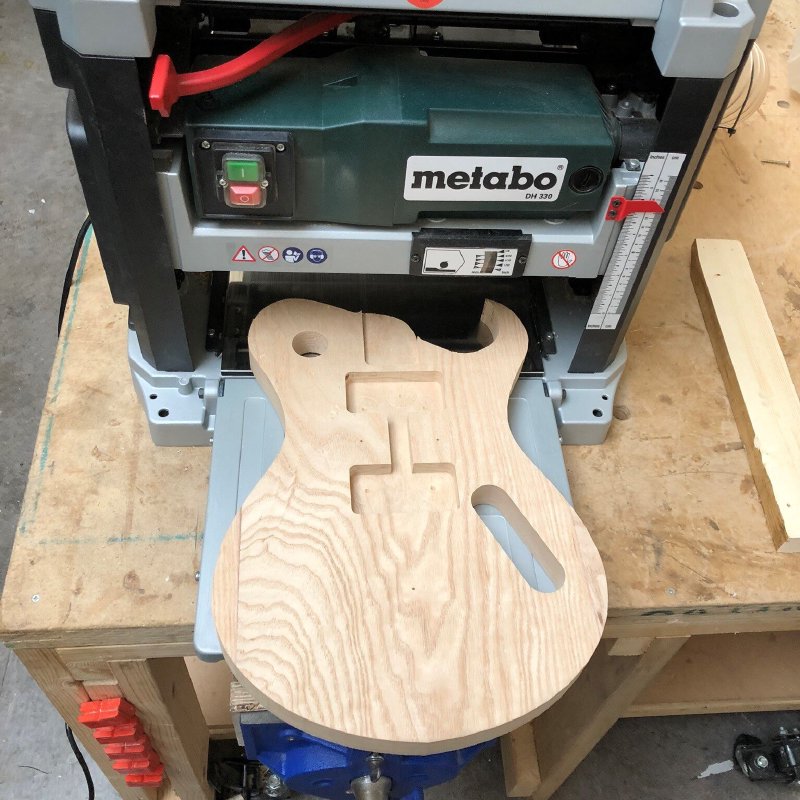
A few minutes later, and we were done, and it was nice and level.
That said, even this wasn’t without incident due to the softness of the wood. I was worried that the agressive blade might tear the wood too much, particularly on the narrow point of the horn, but that didn’t cause any issues thankfully. However, the guide-rail in the thicknesser caused an impression on one of the edges, leaving a vexing mark on the side:
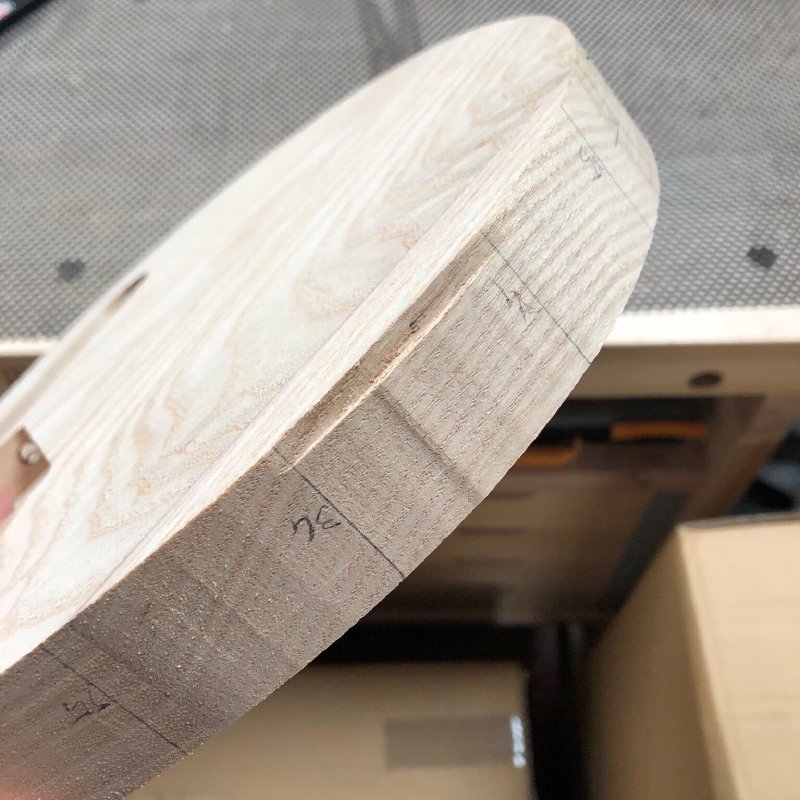
I’ll try steaming the wood to decompress it as much as I can and then sand out the rest as I run the body (lightly!) round the spindle sander to remove the tool marks from where I routed it out in two passes.
So the lesson from this week is that there is such a thing as too light a wood for making a guitar!
With the lower body now being close to complete, it was time to return to the maple cap, which I jointed a few weeks ago.
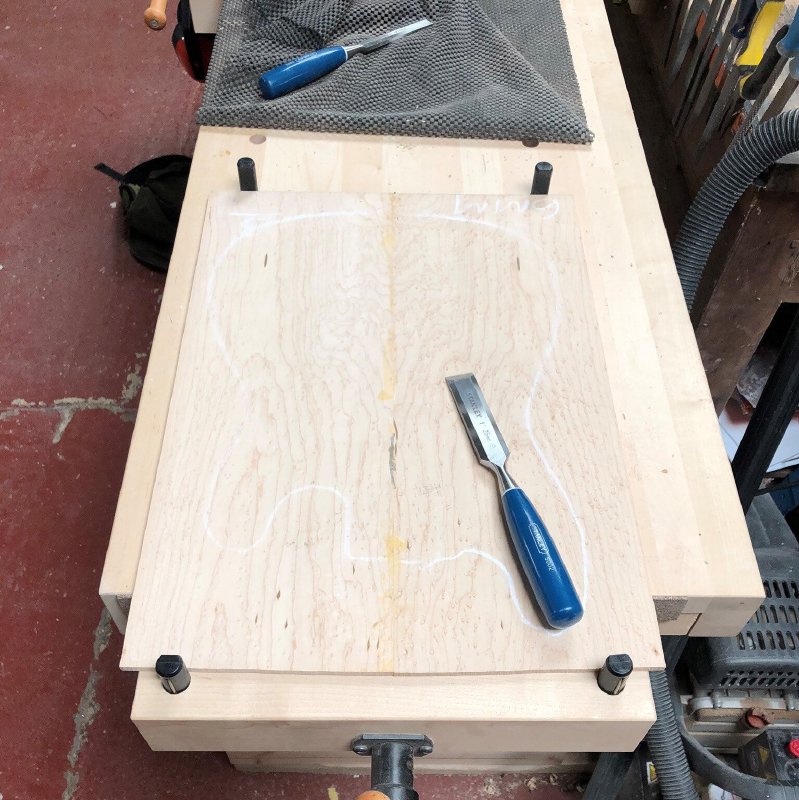
The first task was to remove the glue line and get the seam flat. Thankfully this maple cap is made from sterner stuff than the poplar body, so I could have at it with a chisel, a scraper, and some sandpaper to get rid of the glue on both sides and adjust for any slight misalignment. Once done, I could use my nice transparent templates to work out where I wanted to cut out of the cap to get the nicest bit of wood.
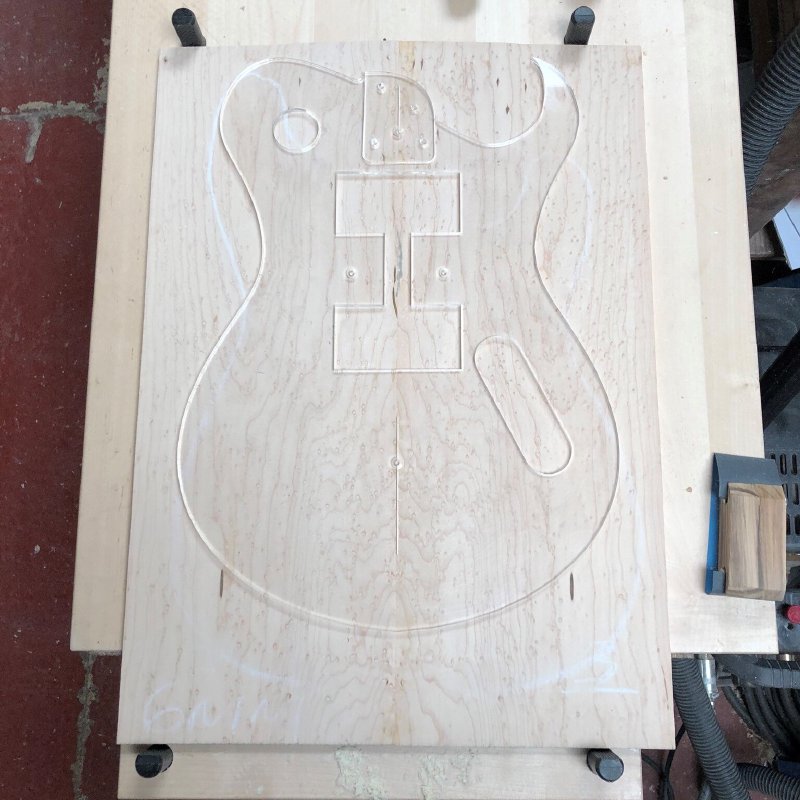
With the position selected, I’m almost ready to glue the body and cap together, but before that I need to provide the electrical shielding to the inside. In the past I’ve used copper tape for this, which looks beautiful, but is harder to do when you’re closing the box like this, and is anyway a fiddly and slow process. So instead I tried out some of the shielding paint that Matt uses on his guitars:
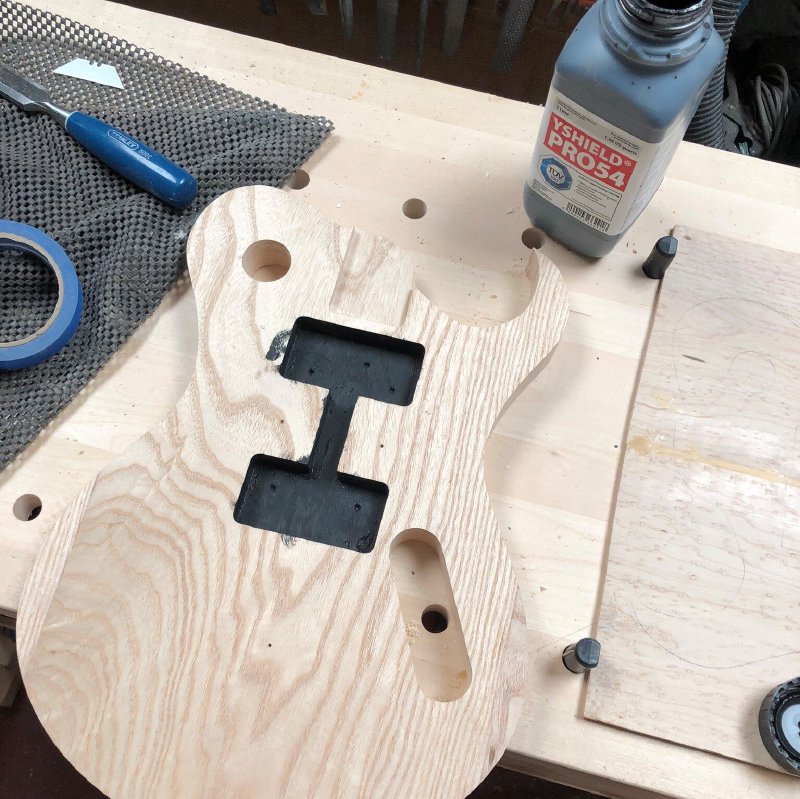
I painted both the body cavities and the underside of the cap where it’ll match up with the body.
Alas I ran out of time this week to actually glue everything up, so that’ll come next week.
If you read this blog back in March you’d have seen I was given an Antoria strat copy to tune up, mostly because the electronics were a bit shot. Unfortunately lockdown meant that didn’t get done, so I’ve finally started on that.
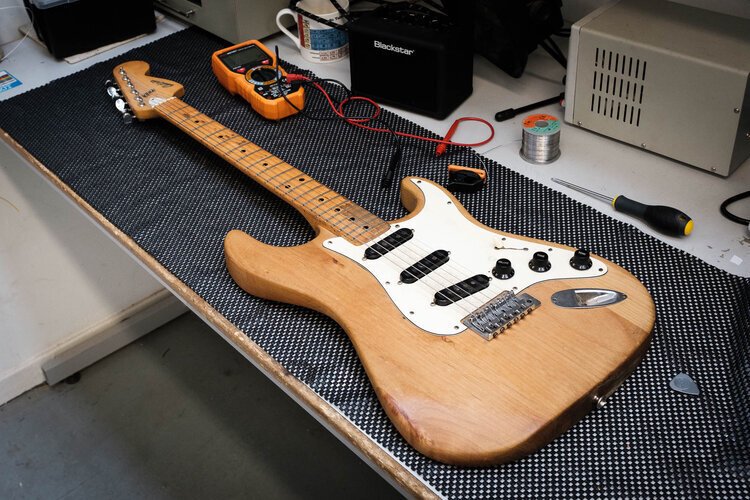
The guitar is interesting, as it’s clearly had a mongrel life. You can see the neck and the body didn’t originally go together, as the original mount holes have been plugged and new ones added:

The neck is more narrow than the body’s neck pocket, and when I got the guitar it was shimmed with a couple of bits of cardboard. To tidy that up, I’ve glued in a couple of bits of wood veneer that I’ll trim down flush and oil after.
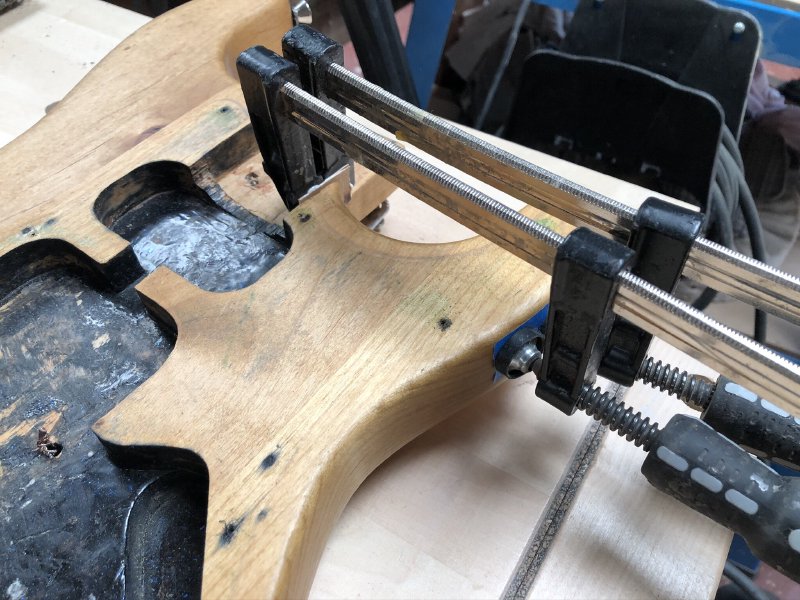
The veneer I’m using should match the body reasonably closely, and certainly closer than the white cardboard that was there before.
I did a few more laser-cut pick-guards for Matt. The only thing notable this week that I did different to the previous weeks was I manually tweaked the designs to adjust for kerfing (the fancy name for the material lost as the laser vapourises it) on the screw holes, which seemed to be suffering more than any other part of the design. I have to confess I just did this in Adobe Illustrator given that Fusion 360 was struggling with the STEP files Matt had generated from TurboCAD. Thankfully my day-job requires I occasionally use Illustrator in anger so this didn’t take long.
The last task I did this week was upgrade my workbench, by copying what my workshop stablemate has done to his: adding some magnetic rails to keep common tools on.

Whilst my workbench does have plenty of storage under it, for things like my bradawl, screwdrivers, etc. I’d like those to be in arms reach. I’ve only done one side of the workbench though, as the Sjoberg I have is quite narrow, so I want to have one half where I can have over-sized bits of wood hang of either side if necessary.